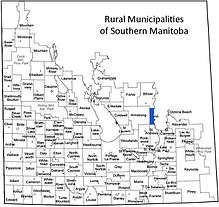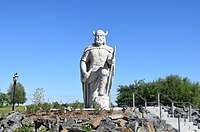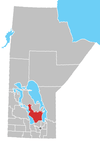Rural Municipality of Gimli
Gimli is a rural municipality located in the Interlake Region of south-central Manitoba, Canada, on the western shore of Lake Winnipeg. It is about 75 kilometres (47 mi) north of the provincial capital Winnipeg. The rural municipality's population in the Canada 2016 Census was 6,181.
Gimli, Manitoba | |
|---|---|
 Gimli Public School Building, constructed in 1915, and now site of the RM of Gimli's offices. | |
| Motto(s): The Heart of New Iceland[1] | |
 Gimli, Manitoba | |
| Coordinates: 50°39′43″N 97°01′47″W | |
| Country | Canada |
| Province | Manitoba |
| Region | Interlake |
| Demonym: | Gimlungur (singular); Gimlungar (plural) |
| Founded | October, 1875 |
| Incorporated as rural municipality | March 15, 1881[2] |
| Amalgamated with Town of Gimli | January 1, 2003[2] |
| Government | |
| • Mayor | Lynn Greenberg |
| Area | |
| • Land | 318.75 km2 (123.07 sq mi) |
| Elevation | 222 m (728 ft) |
| Population (2016) | |
| • Total | 6,181 |
| • Density | 19.5/km2 (51/sq mi) |
| • Urban density | 319.25/km2 (826.9/sq mi) |
| Postal code | R0C 1B0 R0C 1B1 |
| Area code(s) | 204, 431 |
| Website | gimli.ca |
The town of Gimli and surrounding districts were once an Icelandic ethnic block settlement, and the area, known as New Iceland, is home to the largest concentration of people of Icelandic ancestry outside Iceland. It also has significant Ukrainian and German communities, at 12% and 6% respectively.
The Town of Winnipeg Beach lies adjacent to its southeast corner, on the shores of Lake Winnipeg, between it and the Rural Municipality of St. Andrews to the south.
Communities

- Arnes
- Camp Morton
- Gimli
- Husavik
- Sandy Hook
History

Gimli was founded by a large group of Icelandic settlers who arrived in New Iceland on Lake Winnipeg in the 1870s.[1] Beyond the borders of Manitoba as it was then, this settlement fell within the District of Keewatin, until 1881 when Manitoba was enlarged. In 1876 the community was hit by a severe outbreak of smallpox. Originally organized as a self-administering "Icelandic reserve" directly responsible to Ottawa, the settlers of New Iceland developed a unique constitution of by-laws for local government which remained in effect until they adopted provincial municipal government in 1887. The initial status of New Iceland as a "reserve" remained in effect until 1899.
In the Gimli Glider incident on 23 July 1983, an Air Canada Boeing 767 en route from Montreal to Edmonton ran out of fuel and made an unpowered landing on a decommissioned runway (converted to a drag strip) at Gimli Industrial Park Airport, a former RCAF base near Gimli with no control tower and no fire trucks available. A reenactment of the incident aired on Discovery Channel's Mayday series and on Syfy's Urban Legends series.
The Town of Gimli amalgamated with the Rural Municipality of Gimli on January 1, 2003.[2][3]
Economy
There are over 100 commercial fishers in Gimli, catching white fish and pickerel.[4] During the summer months, tourism is a major industry, as thousands of summer cottagers fill the town of Gimli, especially on weekends. Hotels, restaurants and stores cater to the summer visitors.
Two of the largest employers in Gimli are the Gimli Distillery and Faroex [5] (a division of Sigma Industries). The Gimli Distillery opened in 1968. The plant employs 72 people with an annual payroll of almost C$4 million. The operation is situated on two quarters of land and comprises a production building, barrel filling and dumping, and 46 warehouses to store the maturing whiskies. The plant, the source of Crown Royal whisky, produces the company's global Canadian whisky requirement. Faroex Ltd., established in 1981, produces composite components for use in the agricultural, automotive, consumer and military supply industries. Their first product was a flooring and support framing system made from plastic and fibreglass, used in hog production.
Smaller companies include Interlake Agencies, a local real estate and insurance company that started in Gimli in 1962 and is now the largest seller of real estate in the Interlake region and one of the largest independent real estate companies in Manitoba.[6]
Demographics
| Population | Percentage | |
|---|---|---|
| Icelandic | 1,510 | 26.5 |
| English | 1,385 | 24.3 |
| Ukrainian | 1,265 | 22.2 |
| Scottish | 1,070 | 18.8 |
| German | 985 | 17.3 |
| Irish | 830 | 14.6 |
| Polish | 830 | 14.6 |
| Canadian | 670 | 11.8 |
| Year | Pop. | ±% |
|---|---|---|
| 1981 | 2,237 | — |
| 1986 | 2,458 | +9.9% |
| 1996 | 3,124 | +27.1% |
| 2001 | 3,501 | +12.1% |
| 2006 | 5,797 | +65.6% |
| 2011 | 5,845 | +0.8% |
| 2016 | 6,181 | +5.7% |
The Rural Municipality of Gimli had a population of 6,181 as of the Canada 2016 Census, an increase of 5.7% since the last census in 2011.[8] The average age of RM of Gimli residents was 51.4 years old, this was well over the provincial average of 39.4 The percentage of the population 65 years or older was 33.5% of the population, this was nearly double the provincial average of 15.6% of the population in the age bracket.[8]
Gimli residents claim Icelandic heritage as the largest part of their ethnic background with 26.5% of the entire rural municipality claiming some Icelandic background or 1,510 people.[7] Close behind are those that claim English and Ukrainian background at 24.3% and 22.2% respectively.
Water
In August 2016 the Province and Federal government announced they will cost-share upgrades to the water treatment and distribution systems in the City of Selkirk and the R.M. of Gimli. Estimated total cost of the Gimli upgrade project was C$18 million.[9]
The R.M. completed construction in November 2018 and opened a new Water Treatment Plant located at the Gimli Industrial Park, added two wells, replaced 8,000 metres (26,000 ft) of (distribution?) pipes, 1,200 metres (3,900 ft) of water main pipe. The water distribution infrastructure serves Gimli and the nearby cottages of Pelican Beach. The project cost a total of C$7 million and was cost-shared by all three levels of government.[10]
Arts and culture

Gimli celebrates its heritage with the Icelandic Festival on August long weekend.[11] The first Icelandic festival in Manitoba was held in Winnipeg in 1890; it was held there annually until 1931, and since 1932 has been held in Gimli.
The celebration showcases the work of local artists in downtown Gimli. Tourists are able to purchase anything from jewellery to paintings and Viking and Icelandic memorabilia. A popular sight in the town is the pier which extends from the downtown shoreline out onto Lake Winnipeg and features the Gimli Seawall Gallery, a cement wall 977 feet (298 m) long featuring 72 murals which depict the history and stories of the community.[12]
The Gimli Film Festival is held annually;[13] it features an 11-metre (36 ft) outdoor screen on Lake Winnipeg. The Gimli Model Fest and R/C Airshow is an annual R/C hobby showcase, the largest in mid-Canada;[14] its Sunday afternoon air show includes jets with miniature turbine jet engines, warbirds, aerobatics, R/C combat and a kids' candy drop.
Winnipeg director Guy Maddin made a feature film titled Tales from the Gimli Hospital.
Mid-June 2011 saw the arrival of CJ 107.5,[15] a local radio station featuring a mixture of both country and classical rock. The station is located in the Lakeview Hotel,[16] broadcasting in Gimli and the surrounding Interlake area.
Climate
Under the Köppen climate classification, Gimli has a humid continental climate with vast temperature differences between summer and winter, owing to its northerly latitude and distance to coastlines. As a result, summers are warm and sometimes hot, with winters sometimes being bitterly cold.
Gimli has a sunny climate, with an average of 318 days with measurable sunshine per year.[17] The municipality has warm summers; however, the close proximity to Lake Winnipeg cools the summer temperature compared to locations further inland. Winter moderation from the lake is eliminated because Lake Winnipeg freezes over in winter due to the cold continental tendencies. Spring and autumn are short seasons but contain comfortable temperatures.
| Climate data for Gimli, Manitoba | |||||||||||||
|---|---|---|---|---|---|---|---|---|---|---|---|---|---|
| Month | Jan | Feb | Mar | Apr | May | Jun | Jul | Aug | Sep | Oct | Nov | Dec | Year |
| Record high °C (°F) | 8.2 (46.8) |
8.1 (46.6) |
15.0 (59.0) |
29.2 (84.6) |
36.1 (97.0) |
36.7 (98.1) |
35.0 (95.0) |
37.5 (99.5) |
36.5 (97.7) |
26.1 (79.0) |
22.8 (73.0) |
6.3 (43.3) |
37.5 (99.5) |
| Average high °C (°F) | −12.8 (9.0) |
−9.3 (15.3) |
−1.8 (28.8) |
8.2 (46.8) |
16.3 (61.3) |
21.6 (70.9) |
24.9 (76.8) |
23.2 (73.8) |
16.9 (62.4) |
9.5 (49.1) |
−1.1 (30.0) |
−10.5 (13.1) |
7.1 (44.8) |
| Daily mean °C (°F) | −18.2 (−0.8) |
−14.8 (5.4) |
−7.3 (18.9) |
2.7 (36.9) |
10.6 (51.1) |
16.1 (61.0) |
19.2 (66.6) |
17.5 (63.5) |
11.6 (52.9) |
4.8 (40.6) |
−5.2 (22.6) |
−15.4 (4.3) |
1.8 (35.2) |
| Average low °C (°F) | −23.5 (−10.3) |
−20.3 (−4.5) |
−12.8 (9.0) |
−2.9 (26.8) |
4.7 (40.5) |
10.5 (50.9) |
13.5 (56.3) |
11.8 (53.2) |
6.3 (43.3) |
0.0 (32.0) |
−9.2 (15.4) |
−20.3 (−4.5) |
−3.5 (25.7) |
| Record low °C (°F) | −41.2 (−42.2) |
−39.4 (−38.9) |
−34.4 (−29.9) |
−25.6 (−14.1) |
−9.5 (14.9) |
−1.3 (29.7) |
2.8 (37.0) |
0.5 (32.9) |
−15.8 (3.6) |
−16.4 (2.5) |
−34.3 (−29.7) |
−39.4 (−38.9) |
−41.2 (−42.2) |
| Average precipitation mm (inches) | 22.2 (0.87) |
17.3 (0.68) |
30.0 (1.18) |
30.0 (1.18) |
49.8 (1.96) |
94.1 (3.70) |
69.7 (2.74) |
64.2 (2.53) |
66.7 (2.63) |
38.3 (1.51) |
27.6 (1.09) |
22.5 (0.89) |
532.5 (20.96) |
| Average rainfall mm (inches) | 0.3 (0.01) |
0.3 (0.01) |
8.8 (0.35) |
19.8 (0.78) |
47.6 (1.87) |
94.1 (3.70) |
69.7 (2.74) |
64.2 (2.53) |
65.6 (2.58) |
30.3 (1.19) |
5.3 (0.21) |
1.8 (0.07) |
407.8 (16.06) |
| Average snowfall cm (inches) | 27.6 (10.9) |
21.7 (8.5) |
24.1 (9.5) |
11.4 (4.5) |
2.2 (0.9) |
0 (0) |
0 (0) |
0 (0) |
1.1 (0.4) |
8.4 (3.3) |
26.6 (10.5) |
25.0 (9.8) |
148.1 (58.3) |
| Average precipitation days (≥ 0.2 mm) | 12.3 | 9.2 | 9.5 | 8.1 | 9.9 | 12.7 | 11.7 | 11.6 | 11.1 | 10.0 | 9.4 | 12.4 | 127.6 |
| Average rainy days (≥ 0.2 mm) | 0.30 | 0.35 | 2.5 | 5.6 | 9.5 | 12.7 | 11.7 | 11.6 | 10.9 | 8.2 | 2.3 | 0.53 | 76.1 |
| Average snowy days (≥ 0.2 cm) | 13.9 | 9.7 | 8.5 | 3.7 | 1.0 | 0.05 | 0 | 0 | 0.45 | 2.6 | 8.6 | 13.6 | 62.0 |
| Mean monthly sunshine hours | 119.3 | 141.2 | 190.3 | 247.5 | 284.4 | 289.6 | 319.1 | 271.8 | 174.8 | 141.1 | 94.9 | 102.4 | 2,376.4 |
| Source: Environment Canada[17] | |||||||||||||
Notable people
- David Arnason: writer and English professor born in Gimli.
- Leo Kristjanson: economist and president of the University of Saskatchewan from 1980 to 1989.
- Gunnar Thorvaldson: Conservative senator, Senate of Canada.
- John MacDonald: Canadian musician.
- Vilhjálmur Stefánsson: ethnologist and Arctic explorer.
- Eric Stefanson: retired Manitoba Progressive Conservative politician born in Gimli.
- W. D. Valgardson: writer and professor.
- George Johnson: physician and former Minister of Education and Health in Manitoba, as well as the Lieutenant Governor of Manitoba.
- Hans Wuthrich: world-renowned curling ice technician.
- Peter Bjornson: Politician, Teacher, Governor General's Award winner and former Minister of Education in Manitoba.
References
- "Close-Up: The Canadian town known as 'New Iceland'". BBC News. 11 June 2011.
- "Manitoba Communities: Gimli (Rural Municipality)". Manitoba Historical Society. Retrieved 2017-08-08.
- "Gimli: The Evolution of a Community". Rural Municipality of Gimli. Retrieved 26 January 2013.
- http://www.dfo-mpo.gc.ca/sch/Forum/foru111_e.pdf (broken link)
- Faroex
- Interlake Agencies
- "RM of Gimli Demographics". Statistics Canada. Retrieved 10 August 2017.
- "RM Gimli Census profile". Statistics Canada. Retrieved 2017-08-10.
- "Selkirk, Gimli getting new water treatment plants | Winnipeg Sun". Winnipeg Sun. August 5, 2016. Retrieved February 13, 2020.
- "New water treatment plant opens in RM of Gimli". CTV News Winnipeg. November 16, 2018. Retrieved February 13, 2020.
- Icelandic Festival of Manitoba
- Seawall, Gimli Art Club
- Gimli Film Festival
- Gimli Model Fest and R/C Airshow
- CJ 107.5
- Lakeview Hotel
- "Canadian Climate Normals 1971–2000". Environment Canada. Retrieved March 19, 2012.
